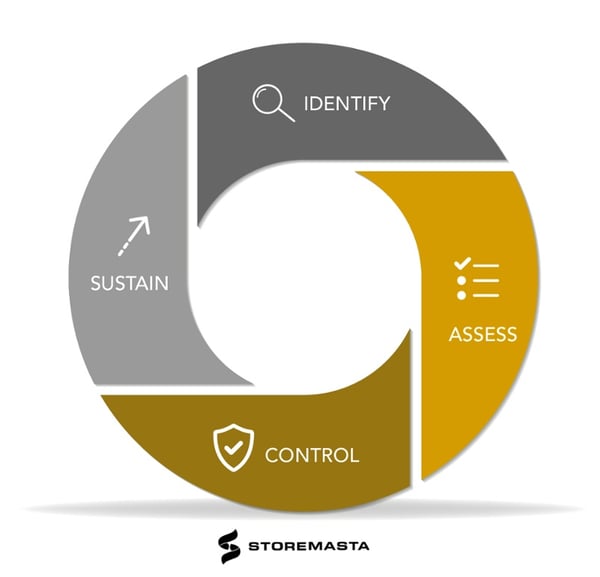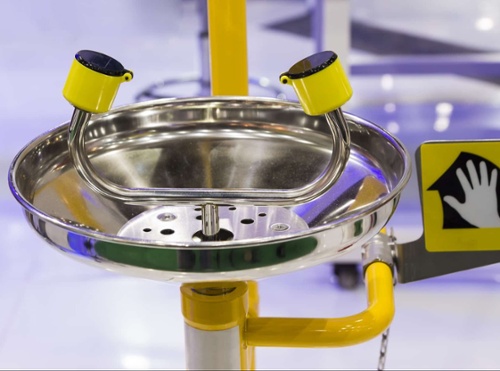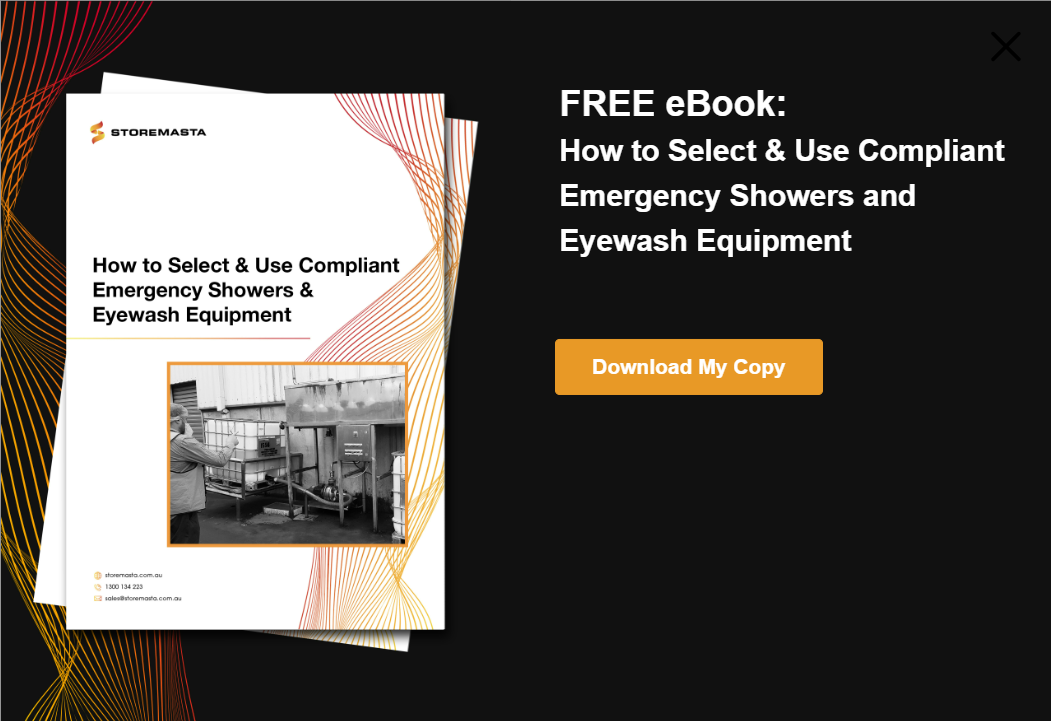Risk management is a process of identifying hazards, then finding ways to eliminate or minimise the harm they can cause. At the same time, you’re monitoring any safety controls already in place to make sure they are working. In the event of a spill or accident with hazardous chemicals, it’s essential that your emergency shower and eyewash station are operating correctly. And for this to occur, you’ll need to consider how your decontamination equipment is installed, used and maintained.
This post explains how to bring a risk management approach to the installation of emergency decontamination equipment, such as your safety showers and eyewash stations. We use one generic example to demonstrate the process.
What Is Emergency Decontamination Equipment?
Emergency decontamination facilities are pieces of safety equipment used for the purposes of decontaminating staff in the event of an accident. The decontamination of staff with a controlled flow of water allows for hazardous substances or foreign objects to be quickly removed from the eyes or skin. Times when emergency decontamination equipment may be required includes the spilling of hazardous chemicals, the release of harmful gases, or even situations where staff have been cut by a sharp material — such as glass.
Examples of emergency decontamination equipment may include:
- Safety shower
- Eyewash station
- Combination safety shower and eyewash station
- Drench hose
Why Do You Need a Risk Assessment for Safety Showers and Eyewash Stations?
To help you look after your staff and ensure safety in your workplace, our team at Storemasta have developed a proven risk management methodology.
This systematic approach can be applied to your chemical handling and storage areas, as well as other parts of your workplace – such as your emergency decontamination facilities.
By taking a risk management approach to your safety showers and eyewash stations, you’ll ensure that you’re selecting, implementing, using and maintaining your equipment to ensure optimum safety.
Risk Management Methodology: Safety Shower and Eyewash Station Installations
The Storemasta Risk Management Methodology consists of 4 steps which continue in a perpetual circle, so each hazard is continually reviewed and assessed.
Let’s look at it in action using the example below.
SCENARIO: You’ve just been appointed HSE Manager at a food manufacturing plant and during an inspection you notice there is no safety shower or eyewash station in the laboratory. You carry out a risk assessment to determine if the purchase is necessary, and if it is — install the most effective equipment.

STEP 1: IDENTIFY the hazards
The first step is to clearly identify the hazardous chemicals or materials used/stored in the work area. You’ll have to refer to the material safety data sheets to properly identify the hazardous chemicals in your organisation.
Your inspection of the area is accompanied by the lab manager and another technician, they indicate some containers of acids and bases kept on shelves near their work benches. The lab technician informs you that there is a shower in the restrooms, as well as a soft-spray hose if there was a need to flush contaminants from the eyes.
STEP 2: ASSESS the risk
The next step is to assess how each of these hazards could injure your workers, taking into account the severity of the injuries. This risk assessment process will help you determine your emergency decontamination needs.
After consulting the safety data sheets of the acids and bases, you note that the hazardous chemicals have the potential cause severe skin and eye damage (including 2nd and 3rd degree burns), permanent blindness and even death. The safety data sheet recommends the installation of a safety shower and emergency eyewash unit.
You already know that the Australian Standard, AS 4775- Emergency eyewash and shower equipment, states that an emergency decontamination unit must be accessible to workers within 10 seconds. The safety shower and emergency eyewash must also comply with the specifications of the Australian Standard.
Therefore, during your risk assessment, you determine that the domestic shower and spray hose are insufficient as an emergency wash station for these hazardous chemicals.
In addition to this, you note that there are times when two lab staff are working together with the chemicals. This means that in the event of a chemical emergency, both technicians may need to use a decontamination station at the same time.
You also note the incompatible acids and bases stored together which could potentially react with one another. Your risk assessment process provides the conclusion that the workplace requires the installation of a counter-mounted eyewash between the two workbenches, with a drench hose at the sink. You’ll also install a combination safety shower and eyewash station.
Your risk assessment process may determine the type and location of equipment you’ll need for emergency decontamination.
STEP 3: Introduce CONTROL measures
The third step in this risk management methodology will help you decide if you’ll need to implement any additional control measures to ensure the effectiveness and safety of the installation.
Because the technicians have been relying on a domestic shower in restrooms for years, you realise that you’ll need to draft up new operating procedures — and provide training to each of the workers. You’ll also need some additional engineering controls, including a corrosive storage cabinet, that will safely segregate the acids and bases in fully contained sections of the cabinet.
IMPORTANT: To learn more about developing operating procedures for your safety shower and eyewash, read our popular post.
STEP 4: Review and SUSTAIN compliance
The fourth and final step in this risk management process is to implement systems so that the hazards, equipment and controls are regularly reviewed. By regularly conducting risk assessments and equipment/control inspections, you’ll be able to sustain compliance in your operations.
Three months after the installation of the safety shower and eyewash station, counter-mounted eyewash, and the corrosive safety cabinet, you conduct a safety audit in the lab.
The acids and bases are now being stored correctly in the under-bench corrosive cabinet. However, after checking the weekly inspection logs, you discover that sometimes the decontamination units are not being activated on a weekly basis.
Also, one of the workers has started using the sink under the eyewash unit for rinsing chemicals from glassware — which creates a new hazard for any worker using the eyewash unit for emergency decontamination.
By re-assessing the laboratory, you’re able to quickly rectify these safety equipment issues, as well as ensure that the equipment and controls are being properly used and maintained by staff.
IMPORTANT: Are you concerned about staff not using the safety equipment in the correct way? Find out more about the 5 key ways staff misuse emergency decontamination equipment by reading our blog.
Why a Risk Management Approach?
When planning the installation of any safety or emergency equipment, a risk management approach is always recommended because it looks at the project holistically and focuses on identifying potential problems before you spend money.
Hazards and problems can be eliminated before the project even starts.
Additionally, if you use a proven risk management methodology, such as Storemasta’s 4-step process, you can feel confident that each hazard and control measure is systematically identified, assessed and reviewed until compliance is achieved and sustained.
Keeping records of the risk management process demonstrates what you have done to comply with the WHS Act and WHS Regulations. It also helps when undertaking subsequent risk management activities, including reviewing your control measures. - Safe Work Australia
Need an Eyewash and Safety Shower Risk Assessment?
Now you have a better understanding of the risk management process — and the steps to take when deciding on the most suitable emergency decontamination equipment for your workplace — why not download our free eBook? How to select and use compliant emergency showers and eyewash equipment will help you determine your emergency decontamination equipment needs and install the correct equipment for your operations.
Joining the team as a Dangerous Goods Storage Consultant, Melissa Hampton became Storemasta's Marketing Manager in late 2021. With extensive knowledge and experience in chemical compliance, Melissa is responsible for leading the Marketing team and helping shape their marketing strategy. In her spare time, you can find Melissa hiking, swimming and enjoying the great outdoors in beautiful north-west Tasmania.

